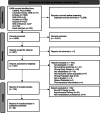The influence of telehealth-based cancer rehabilitation interventions on disability: a systematic review
- PMID: 35218521
- PMCID: PMC8881759
- DOI: 10.1007/s11764-022-01181-4
The influence of telehealth-based cancer rehabilitation interventions on disability: a systematic review
Abstract
Purpose: To characterize delivery features and explore effectiveness of telehealth-based cancer rehabilitation interventions that address disability in adult cancer survivors.
Methods: A systematic review of electronic databases (CINAHL Plus, Cochrane Library: Database of Systematic Reviews, Embase, National Health Service's Health Technology Assessment, PubMed, Scopus, Web of Science) was conducted in December 2019 and updated in April 2021.
Results: Searches identified 3,499 unique studies. Sixty-eight studies met inclusion criteria. There were 81 unique interventions across included studies. Interventions were primarily delivered post-treatment and lasted an average of 16.5 weeks (SD = 13.1). They were most frequently delivered using telephone calls (59%), administered delivered by nursing professionals (35%), and delivered in a one-on-one format (88%). Risk of bias of included studies was primarily moderate to high. Included studies captured 55 measures of disability. Only 54% of reported outcomes had data that allowed calculation of effect sizes ranging -3.58 to 15.66.
Conclusions: The analyses suggest small effects of telehealth-based cancer interventions on disability, though the heterogeneity seen in the measurement of disability makes it hard to draw firm conclusions. Further research using more diverse samples, common measures of disability, and pragmatic study designs is needed to advance telehealth in cancer rehabilitation.
Implications for cancer survivors: Telehealth-based cancer rehabilitation interventions have the potential to increase access to care designed to reduce disability across the cancer care continuum.
Keywords: Cancer rehabilitation; Disability; Function; Intervention; Neoplasm; Telehealth.
© 2022. This is a U.S. government work and not under copyright protection in the U.S.; foreign copyright protection may apply.
Conflict of interest statement
Drs. Pergolotti and Covington, and Tiffany Kendig report personal fees from Select Medical, ReVital Cancer Rehab outside the submitted work. Julie K. Silver has participated in research funded by the Binational Scientific Foundation and is a venture partner for Third Culture Capital outside of the work submitted. Aneesha Virani receives salary for full-time employment at Northside Hospital for work outside of submitted work. Aneesha Virani reports participating in research funded by the American Speech & Hearing Foundation for work outside of this project. Grace Campbell reports funding from the National Institute of Disability, Independent Living, and Rehabilitation Research. Kathleen D. Lyons reports participating in research funded by the National Cancer Institute for work outside of this project. All other authors declare no competing interests.
Figures
References
-
- Starmer HM. Factors influencing adherence to treatment for head and neck cancer. In: Doyle PC, editor. Clinical care and rehabilitation in head and neck cancer. Cham: Springer International Publishing; 2019. p. 413–22. 10.1007/978-3-030-04702-3_24.
Publication types
MeSH terms
Grants and funding
LinkOut - more resources
Full Text Sources
Medical
Miscellaneous



